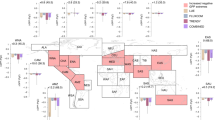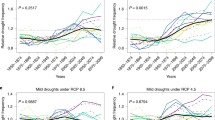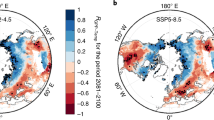Abstract
Future climate warming is expected to enhance plant growth in temperate ecosystems and to increase carbon sequestration1,2. But although severe regional heatwaves may become more frequent in a changing climate3,4, their impact on terrestrial carbon cycling is unclear. Here we report measurements of ecosystem carbon dioxide fluxes, remotely sensed radiation absorbed by plants, and country-level crop yields taken during the European heatwave in 2003. We use a terrestrial biosphere simulation model5 to assess continental-scale changes in primary productivity during 2003, and their consequences for the net carbon balance. We estimate a 30 per cent reduction in gross primary productivity over Europe, which resulted in a strong anomalous net source of carbon dioxide (0.5 Pg C yr-1) to the atmosphere and reversed the effect of four years of net ecosystem carbon sequestration6. Our results suggest that productivity reduction in eastern and western Europe can be explained by rainfall deficit and extreme summer heat, respectively. We also find that ecosystem respiration decreased together with gross primary productivity, rather than accelerating with the temperature rise. Model results, corroborated by historical records of crop yields, suggest that such a reduction in Europe's primary productivity is unprecedented during the last century. An increase in future drought events could turn temperate ecosystems into carbon sources, contributing to positive carbon-climate feedbacks already anticipated in the tropics and at high latitudes1,2.
This is a preview of subscription content, access via your institution
Access options
Subscribe to this journal
Receive 51 print issues and online access
$199.00 per year
only $3.90 per issue
Buy this article
- Purchase on Springer Link
- Instant access to full article PDF
Prices may be subject to local taxes which are calculated during checkout



Similar content being viewed by others
References
Cox, P. M., Betts, R. A., Jones, C. D., Spal, A. S. & Totterdell, I. J. Acceleration of global warming due to carbon-cycle feedbacks in a coupled climate model. Nature 408, 184–187 (2000)
Dufresne, J. L. et al. On the magnitude of positive feedback between future climate change and the carbon cycle. Geophys. Res. Lett. 29(10), doi:10.1029/2001GL013777 (2002)
Schär, C. et al. The role of increasing temperature variability in European summer heatwaves. Nature 427, 332–335 (2004)
Meehl, G. A. & Tebaldi, C. More intense, more frequent, and longer lasting heat waves in the 21st century. Science 305, 994–997 (2004)
Krinner, G. et al. A dynamic global vegetation model for studies of the coupled atmosphere-biosphere system. Glob. Biogeochem. Cycles 19, 1–33 (2005)
Janssens, I. A. et al. Europe's terrestrial biosphere absorbs 7 to 12% of European anthropogenic CO2 emissions. Science 300, 1538–1542 (2003)
Valentini, R. et al. Respiration as the main determinant of carbon balance in European forests. Nature 404, 861–865 (2000)
Aubinet, M. et al. Estimates of the annual net carbon and water exchange of forests: the EUROFLUX methodology. Adv. Ecol. Res. 30, 113–175 (2000)
Reichstein, M. et al. On the separation of net ecosystem exchange into assimilation and ecosystem respiration: review and improved algorithm. Glob. Change Biol. 11, 1–16 (2005)
Granier, A., Bréda, N., Piron, P. & Vilette, S. A lumped water balance model to evaluate duration and intensity of drought constraints in forest stands. Ecol. Modell. 116, 269–283 (1999)
Reichstein, M. et al. Inverse modelling of seasonal drought effects on canopy CO2/H2O exchange in three Mediterranean Ecosystems. J. Geophys. Res. 108, 4716–4721 (2003)
Irvine, J., Perks, M. P., Magnani, F. & Grace, J. The response of Pinus sylvestris to drought: stomatal control of transpiration and hydraulic conductance. Tree Physiol. 18, 393–402 (1998)
Food and Agriculture Organization Databasehttp://faostat.fao.org/faostat/collections?subset=agriculture (2004).
Goudriaan, J., Groot, J. J. R. & Uithol, P. W. J. in Terrestrial Global Productivity (eds Saugier, B. & Roy, J.) (Academic, 2001)
Mitchell, T. D., Carter, T. R., Jones, P. D., Hulme, M. & New, M. A comprehensive set of high resolution grids of monthly climate for Europe and the globe: the observed record (1901–2000) and 16 scenarios (2001–2100). Working paper 55 (Tyndall Centre for Climate Change Research, July 2004); available at http://www.tyndall.ac.uk/publications/working_papers/wp55.pdf.
Simmons, A. J. & Gibson, J. K. The ERA 40 Project Plan. ERA-40 Project Report Series No. 1, 1–62 (European Center for Medium Range Weather Forecasts (ECMWF), 2000)
Myneni, R. B. et al. Global products of vegetation leaf area and fraction absorbed PAR from one year of MODIS data. Remote Sens. Environ. 83(1–2), 214–231 (2002)
Nemani, R. R. et al. Climate-driven increases in global terrestrial net primary production from 1982 to 1999. Science 300, 1560–1563 (2003)
Barber, V. A. et al. Reduced growth of Alaskan white spruce in the twentieth century from temperature-induced drought stress. Nature 405, 668–673 (2000)
Elliot, K. J. & Swank, W. T. Impacts of drought on tree mortality and growth in a mixed hardwood forest. J. Veget. Sci. 5.2, 229–236 (1994)
Tyree, M. T. & Sperry, J. S. Do woody plants operate near the point of catastrophic xylem dysfunction caused by dynamic water stress? Answers from a model. Plant Physiol. 88, 574–580 (1988)
Cherbuy, B., Joffre, R., Gillon, D. & Rambal, S. Internal remobilization of carbohydrates, lipids, nitrogen and phosphorus in the Mediterranean evergreen oak Quercus ilex. Tree Physiol. 21, 9–17 (2001)
Boyer, J. S. Biochemical and biophysical aspects of water deficits and the predisposition to disease. Annu. Rev. Phytopathol. 33, 251–274 (1995)
Schimel, J. S. et al. Moisture effects on microbial activity and community structure in decomposing birch litter in the Alaskan taiga. Soil Biol. Biochem. 31, 831–838 (1999)
Reichstein, M. et al. Severe drought effects on ecosystem CO2 and H2O fluxes at three mediterranean sites: revision of current hypothesis? Glob. Change Biol. 8, 999–1017 (2002)
Büttner, G., Feranec, J. & Jaffrain, G. Corine Land Cover Update 2000. Technical Report 89 (European Environment Agency, 2000); available at http://reports.eea.eu.int/technical_report_2002_89/en.
Mucher, C. A., Steinnocher, K. T., Kressler, F. D. & Heunks, D. Land cover characterization and change detection for envirnmental monitoring of pan europe. Int. J. Remote Sens. 21, 1159–1182 (2000)
Monsi, M. & Saeki, T. Über den Lichfaktor in den Pflanzengesellschaften und seine Bedeutung fur die Stoffproduktion. Jpn. J. Bot. 14, 22–52 (1953)
Acknowledgements
This work is part of the CARBOEUROPE-IP research program funded by the European Union. Eddy-covariance flux towers are also funded by national programmes. M.R. is supported by a European Union Marie-Curie Fellowship. Supercomputing facilities are provided by the French Commissariat à l'Energie Atomique. We thank H. Dolman, M. Heimann and J. Grace for discussions while preparing this manuscript. Author Contributions The first three authors contributed equally to this work: Ph.C. did the analysis, M.R. did the eddy covariance data harmonization and interpretation, and N.V. did the modelling.
Author information
Authors and Affiliations
Corresponding author
Ethics declarations
Competing interests
Reprints and permissions information is available at npg.nature.com/reprintsandpermissions. The authors declare no competing financial interests.
Supplementary information
Supplementary Figure S1
a, Eddy covariance forest site measurements of GPP, TER and NEP from July to September in 2002 and in 2003. b. Same quantities simulated by the biosphere model used to upscale productivity changes over the European continent. c, Measurements of July to September air temperature and annual precipitation changes at each site between 2003 and 2002. (PDF 36 kb)
Supplementary Figure S2
a, Average crop harvest converted to crop NPP for wheat and maize for selected countries in year 2002 and 2003. b, Comparison between observed and modelled changes in crop NPP during 2003 vs. 1998-2002. c, Country averaged July to September air temperature and annual precipitation changes between 2003 and 1998-2002 over cropland areas. (PDF 20 kb)
Supplementary Figure S3
a, Observed versus modelled difference of mean daily gross primary production for each site and month. b, Histogram of observed versus modelled difference of mean daily gross primary production, GPP, for all sites and months. (PDF 39 kb)
Supplementary Figure S4
From top to bottom. Regression of observed and modelled NEE, GPP and TER differences in 2003 vs. 2002 at the eddy-covariance sites as a function of observed air July to September temperature differences (left) and of April to October rainfall differences (right). On the same scale is shown the regression of simulated NEE, GPP and TER changes in 2003 vs. 2002 for all the model grid points over Europe, defined here as the area bounded by 10°W and 37°E in longitude and by 36°N and 69°N in latitude. The eddy covariance observations and the model simulations over Europe illustrate the fact that there is a larger correlation of flux changes with rainfall than with temperature changes. The largest correlation is found for GPP. (PDF 44244 kb)
Supplementary Figure S5
Tree circumference measurements performed at Hesse for the period 1999-2003 on 11 beech trees from the codominant and dominant crown classes. (PDF 40 kb)
Supplementary Figure Legends
Full text explanations to accompany the above Supplementary Figures. (DOC 42 kb)
Rights and permissions
About this article
Cite this article
Ciais, P., Reichstein, M., Viovy, N. et al. Europe-wide reduction in primary productivity caused by the heat and drought in 2003. Nature 437, 529–533 (2005). https://doi.org/10.1038/nature03972
Received:
Accepted:
Issue Date:
DOI: https://doi.org/10.1038/nature03972
This article is cited by
-
Drought projections for the NW Iberian Peninsula under climate change
Climate Dynamics (2024)
-
Understanding changes in heat waves, droughts, and compound events in Yangtze River Valley and the corresponding atmospheric circulation patterns
Climate Dynamics (2024)
-
Application of Thermal Imaging for Assessing Desiccation Stress Memory in Sugarcane and Sorghum Cultivars
Sugar Tech (2024)
-
Land–atmosphere feedbacks contribute to crop failure in global rainfed breadbaskets
npj Climate and Atmospheric Science (2023)
-
European tree-ring isotopes indicate unusual recent hydroclimate
Communications Earth & Environment (2023)
Comments
By submitting a comment you agree to abide by our Terms and Community Guidelines. If you find something abusive or that does not comply with our terms or guidelines please flag it as inappropriate.



